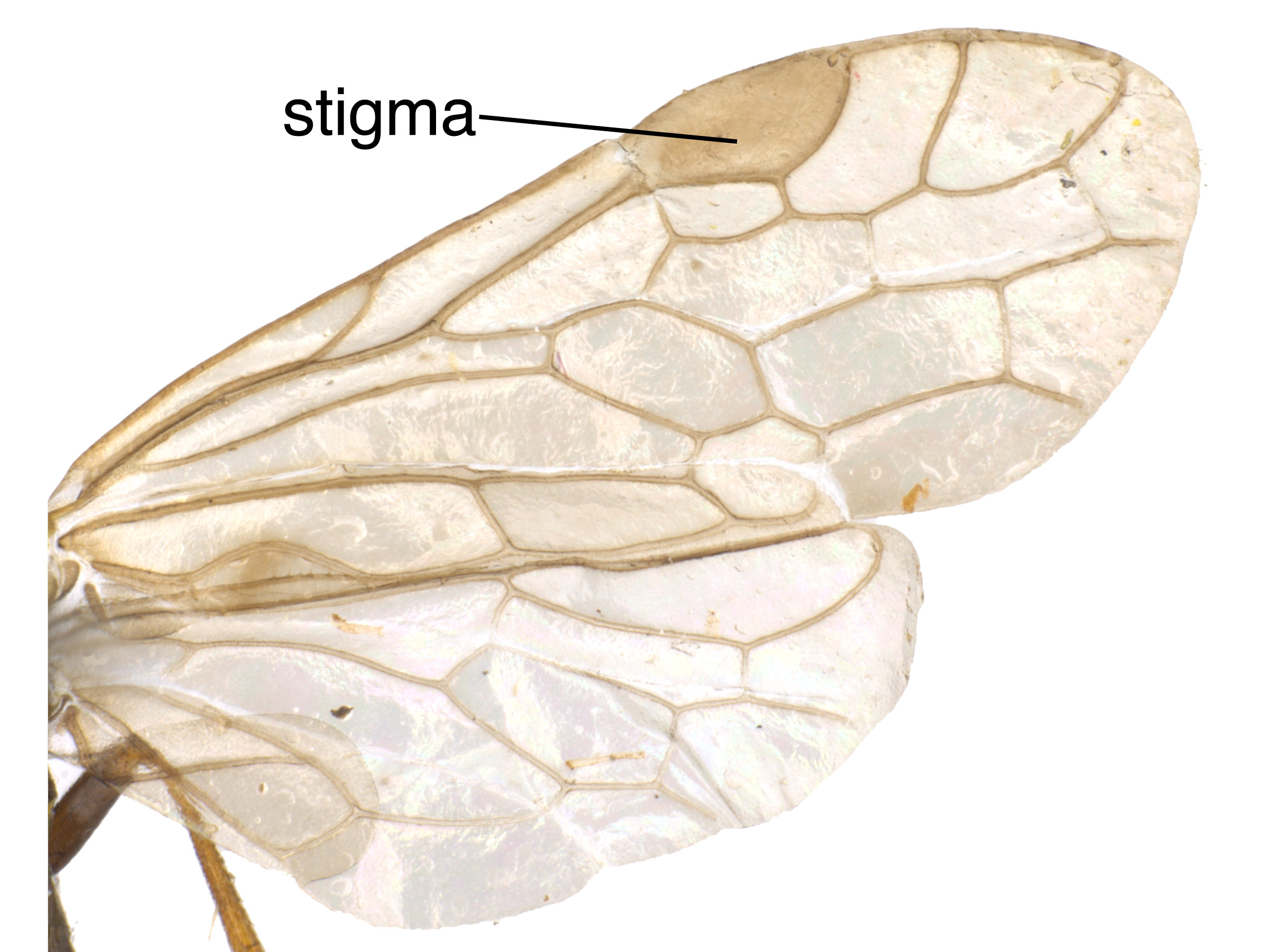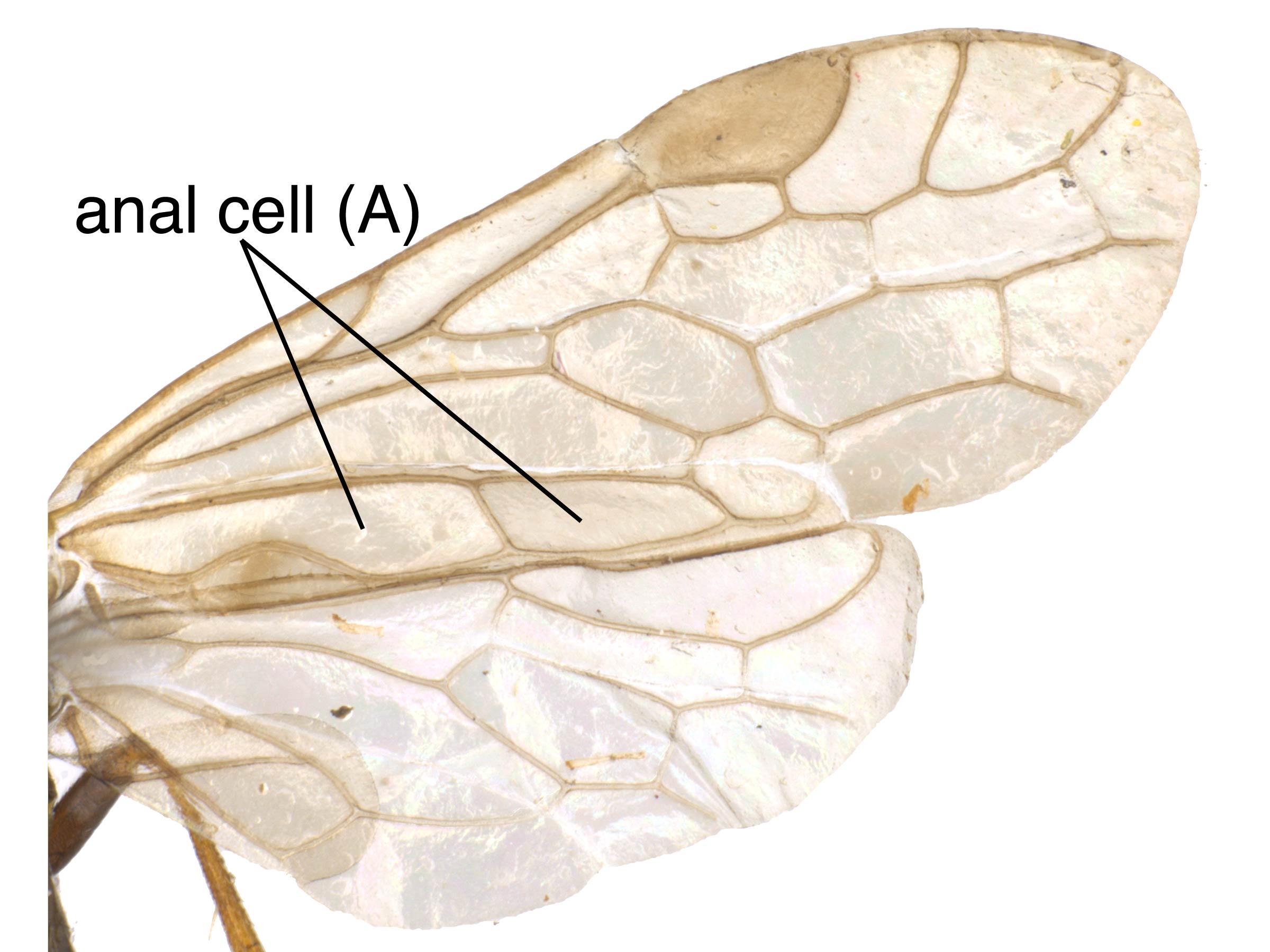Family: Tenthredinidae
Family common name: common sawflies
Subfamily: Nematinae
Tribe: unplaced
Genus: Susana Rohwer & Middleton, 1932
Subgenera: none
The Tenthredinidae are the most species-rich family and are found throughout the world, in all continents but Antarctica. They are known as the “common sawflies.” They can generally be recognized by a cylindrical body and long, segmented antennaeantenna:
the sensory organ emerging from the front of the head, usually between the compound eyes and above the clypeus; includes the flagellum, scape and pedicel
 . Otherwise, they come in a variety of colors, sizes, and forms (Goulet 1992Goulet 1992:
. Otherwise, they come in a variety of colors, sizes, and forms (Goulet 1992Goulet 1992:
Goulet H. 1992. The genera and subgenera of the sawflies of Canada and Alaska: Hymenoptera. Symphyta. The insects and arachnids of Canada. Part 20. Agriculture Canada Publication.).
Nematinae is the second-largest subfamily of Tenthredinidae, with over 1,250 species (Prous et al. 2014Prous et al. 2014:
Prous M, Blank SM, Goulet H, Heibo E, Liston A, Malm T, Nyman T, Schmidt S, Smith DR, Varing;rdal H, Viitasaari M, Vikberg V, and Taeger A. 2014. The genera of Nematinae (Hymenoptera, Tenthredinidae). Journal of Hymenoptera Research 40: 1-69. " target="_blank">https://doi.org/10.3897/JHR.40.7442). They are most diverse in northern Eurasia and North America; only a few species occur in the Southern Hemisphere. Nematinae sawflies have a variety of feeding habits including external leaf feeding, leaf mining, and gall forming, and feed on a variety of hosts (Smith 2003bSmith 2003b:
Smith DR. 2003b. A Synopsis of the sawflies (Hymenoptera: Symphyta) of America south of the United States: Tenthredinidae (Nematinae, Heterarthrinae, Tenthredininae). Transactions of the American Entomological Society 129 (1): 1-45.).
The Nematinae have been subject to numerous revisions in recent years. As of 2021, there are no comprehensive keys to many of the North American species of Nematinae (Prous et al. 2014Prous et al. 2014:
Prous M, Blank SM, Goulet H, Heibo E, Liston A, Malm T, Nyman T, Schmidt S, Smith DR, Varing;rdal H, Viitasaari M, Vikberg V, and Taeger A. 2014. The genera of Nematinae (Hymenoptera, Tenthredinidae). Journal of Hymenoptera Research 40: 1-69. " target="_blank">https://doi.org/10.3897/JHR.40.7442). Because of changing taxonomy and extreme variability in morphology, identifying genera and species in the Nematinae may be more challenging than in other subfamilies of Tenthredindae. For this reason, knowing the host or behaviors of a specimen can be extremely helpful for identification within this subfamily.
Susana was previously placed in its own subfamily due to unusual larval characters and the lack of a prepectusprepectus:
lateral sclerite anterior to mesopleuron (sometimes absent)
in the adults (Smith 1969dSmith 1969d:
Smith DR. 1969d. Nearctic Sawflies. I. Blennocampinae: Adults and larvae (Hymenoptera: Tenthredinidae). Technical Bulletin, U.S. Department of Agriculture 1397: 1-176., Goulet 1992Goulet 1992:
Goulet H. 1992. The genera and subgenera of the sawflies of Canada and Alaska: Hymenoptera. Symphyta. The insects and arachnids of Canada. Part 20. Agriculture Canada Publication.). It is now included in the Nematinae, which are recognized by the clearly convergent fore wingfore wing:
the anterior wing of each pair of wings; usually the largest wing of the pair
 veins M and 1m-cu (Nyman et al. 2006bNyman et al. 2006b:
veins M and 1m-cu (Nyman et al. 2006bNyman et al. 2006b:
Nyman T, Zinovjev AG, Vikberg V, and Farrell BD. 2006b. Molecular phylogeny of the sawfly subfamily Nematinae (Hymenoptera: Tenthredinidae). Systematic Entomology 31: 569-583. https://doi.org/10.1111/j.1365-3113.2006.00336.x). Susana is a western genus. Species are generally about 7–10 mm in length and orange and black in color. Males have somewhat broad, flattened antennaeantenna:
the sensory organ emerging from the front of the head, usually between the compound eyes and above the clypeus; includes the flagellum, scape and pedicel
 (Smith 1969dSmith 1969d:
(Smith 1969dSmith 1969d:
Smith DR. 1969d. Nearctic Sawflies. I. Blennocampinae: Adults and larvae (Hymenoptera: Tenthredinidae). Technical Bulletin, U.S. Department of Agriculture 1397: 1-176., Smith 2006cSmith 2006c:
Smith DR. 2006c. Review of the cypress and juniper sawflies of the genus Susana Rohwer and Middleton (Hymenoptera: Tenthredinidae). Proceedings of the Entomological Society of Washington, 108(1), 62-75.).
There are 10 described species, all of which occur in North America (Taeger et al. 2018Taeger et al. 2018:
Taeger A, Liston AD, Prous M, Groll EK, Gehroldt T, and Blank SM. 2018. ECatSymmdash;Electronic World Catalog of Symphyta (Insecta, Hymenoptera). Program version 5.0 (19 Dec 2018), data version 40 (23 Sep 2018). Senckenberg Deutsches Entomologisches Institut (SDEI), Muuml;ncheberg. https://sdei.de/ecatsym/ Accessed: 28 Jan 2020.).
A key to all species is included in Smith 2006cSmith 2006c:
Smith DR. 2006c. Review of the cypress and juniper sawflies of the genus Susana Rohwer and Middleton (Hymenoptera: Tenthredinidae). Proceedings of the Entomological Society of Washington, 108(1), 62-75..
Subfamily characters
 (Goulet 1992Goulet 1992:
(Goulet 1992Goulet 1992:Genus characters
 about equal in length to second in the female; first flagellomereflagellomere:
about equal in length to second in the female; first flagellomereflagellomere: slightly shorter than second in the male (Smith 1969dSmith 1969d:
slightly shorter than second in the male (Smith 1969dSmith 1969d: of the male slightly flattened laterally (Smith 1969dSmith 1969d:
of the male slightly flattened laterally (Smith 1969dSmith 1969d: junction of veins Sc+R and M widely separated from junction of veins Sc+R and Rs+M (Goulet 1992Goulet 1992:
junction of veins Sc+R and M widely separated from junction of veins Sc+R and Rs+M (Goulet 1992Goulet 1992: vein 2A+3A meeting 1A, making a small basalbasal:
vein 2A+3A meeting 1A, making a small basalbasal: (Smith 1969dSmith 1969d:
(Smith 1969dSmith 1969d: vein 2r-rs usually present (Smith 1969dSmith 1969d:
vein 2r-rs usually present (Smith 1969dSmith 1969d:Susana may be confused with other genera in the subfamily Nematinae, especially Craterocercus, but can be distinguished from it and other genera that have fore wingfore wing:
the anterior wing of each pair of wings; usually the largest wing of the pair
 vein 2A+3A curved upwards and veinvein:
vein 2A+3A curved upwards and veinvein:
a tube-like, often darkened, structure on the wings
 2r-rs present by: the absence of a prepectusprepectus:
2r-rs present by: the absence of a prepectusprepectus:
lateral sclerite anterior to mesopleuron (sometimes absent)
, tarsal clawtarsal claw:
sharpened appendage emerging from the apex of the tarsus
 with short subapical tooth, and a truncatetruncate:
with short subapical tooth, and a truncatetruncate:
ending abruptly; cut off squarely; opposite of tapering
clypeusclypeus:
sclerotized area on the front of the head located between the antennal insertions and labrum
 (Rohwer and Middleton 1932Rohwer and Middleton 1932:
(Rohwer and Middleton 1932Rohwer and Middleton 1932:
Rohwer SA, and Middleton W. 1932. Descriptions of five Nearctic sawflies of the tribe Hemichroini. Proceedings of the Entomological Society of Washington 34(6): 93-98., Smith 1969dSmith 1969d:
Smith DR. 1969d. Nearctic Sawflies. I. Blennocampinae: Adults and larvae (Hymenoptera: Tenthredinidae). Technical Bulletin, U.S. Department of Agriculture 1397: 1-176., Smith 2006cSmith 2006c:
Smith DR. 2006c. Review of the cypress and juniper sawflies of the genus Susana Rohwer and Middleton (Hymenoptera: Tenthredinidae). Proceedings of the Entomological Society of Washington, 108(1), 62-75.). Some species of Pristiphora also lack a defined prepectusprepectus:
lateral sclerite anterior to mesopleuron (sometimes absent)
, but are easily distinguished by the incomplete and straight fore wingfore wing:
the anterior wing of each pair of wings; usually the largest wing of the pair
 vein 2A+3A.
vein 2A+3A.
none
Susana feeds on species of Cupressus (cypress), including C. macrocarpa (Monterey cypress) and C. sempervirens (Mediterranean cypress), and on species of Juniperus (juniper), including J. occidentalis (western juniper) and J. scopulorum (Rocky Mountain juniper) (Smith 2006cSmith 2006c:
Smith DR. 2006c. Review of the cypress and juniper sawflies of the genus Susana Rohwer and Middleton (Hymenoptera: Tenthredinidae). Proceedings of the Entomological Society of Washington, 108(1), 62-75.).
unknown
World: The genus is known only from North America (Goulet 1992Goulet 1992:
Goulet H. 1992. The genera and subgenera of the sawflies of Canada and Alaska: Hymenoptera. Symphyta. The insects and arachnids of Canada. Part 20. Agriculture Canada Publication.).
North America: Susana occurs west of the Rocky Mountains, as far north as British Columbia, and south to Oregon, California, Arizona, and New Mexico (Smith 2006cSmith 2006c:
Smith DR. 2006c. Review of the cypress and juniper sawflies of the genus Susana Rohwer and Middleton (Hymenoptera: Tenthredinidae). Proceedings of the Entomological Society of Washington, 108(1), 62-75.).
Map data from: GBIF.org (29 October 2019) GBIF Occurrence Download Susana and the Oregon State Arthropod Collection (OSAC)
Details about data used for maps can be found here.